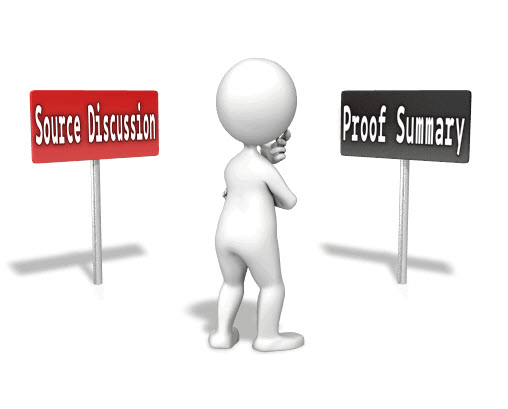
Mary is perplexed. As a family researcher, she has found a derivative source (a newspaper account) that mentions an original court record. But diligent efforts to find the original have been fruitless. How does she report this? she asks, in another forum.
As usual, she received a variety of opinions. As usual, there were substantial contradictions between them and some confusion over concepts. Let’s try to iron out a few of them.
Two issues are being merged here:
- A discussion of the credibility of one individual source
- A conclusion that a certain “fact” is “proved”
One source cannot prove a fact. Therefore, a discussion of one source cannot be a proof summary.
In genealogical research, proof is not achieved until we have met all five criteria of the Genealogical Proof Standard (GPS):
- Reasonably exhaustive research
- Identification of sources used to reach the conclusion, with emphasis on the best possible sources (Mary's specific issue)
- Correlation and analysis of evidence
- Resolution of any conflicting evidence
- A written proof summary (or, in complex cases, a proof argument)
Mary is correct. Her situation calls for a source discussion. Her problem focuses on one source. A thorough search for one source does not meet even the first criteria of the GPS: reasonably exhaustive research. (Yes, there’s a difference between “search” and “research.”)
The “reasonably exhaustive research” standard means using all available types of sources for the time and place—all types, any of which could yield evidence to support or contradict the facts asserted in the newspaper account.
After Mary has used all known and discoverable relevant sources for the problem, then she is ready to reach a conclusion about a “fact” relating to identity or kinship. At that point, she has several options:
- If she finds multiple credible sources that (a) make an explicit statement of fact to answer her research question—i.e., direct evidence—and (b) all agree, then she might simply assert the statement in her narrative and link it to a reference note that lists her sources. She is, in other words, making a proof statement or proof summary.
- If she has multiple credible sources that (a) conflict; or (b) don’t make a direct statement of fact about her point but can be used together to build a case (indirect or negative evidence), then she would write a proof argument.
- If she concludes that the evidence is not sufficient to prove the case, then the question remains unsolved until or unless sufficient evidence is found. In that case, she may wish to write an analysis of what she has found and identify the possibilities for which better evidence is needed before the question can be resolved.
In the meanwhile, right now, Mary is trying to deal with just one step along that path to an eventual conclusion. For the time being, she has one source: a secondhand account. She needs to identify that and document the efforts she has made to find a better version of the information claimed in that secondhand account.
Mary’s initial instinct was correct and the solution is simple:
- In her narrative account of that person’s life, she would state whatever the newspaper account told her, with caveats if she feels it is questionable.
- In an attached reference note, she would identify the newspaper. Then, for however much space it takes, she would explain that the source’s information is secondhand and identify the efforts she has made to find the original record.
One basic rule can help in situations such as this:
Sources are discussed in our reference notes (footnotes or endnotes). Proof arguments about a person’s identity or relationships are usually presented in our discussion of the person.
Exceptions exist to every rule, of course. We handle those in two ways:
- We learn the basic rules.
- We regularly read peer-reviewed journals to learn the kinds of exceptions that can exist and how they can be handled.
IMAGE CREDIT:
Adapted from PresenterMedia (https://www.presentermedia.com : downloaded 10 December 2018), item 19419; customized and used under license.
HOW TO CITE:
Elizabeth Shown Mills, "Does This Call for a Source Discussion or a Proof Summary?," blog post, QuickTips: The Blog @ Evidence Explained (https://www.evidenceexplained.com/quicktips/does-this-call-for-source-discussion-or-proof-summary : posted 10 December 2018).